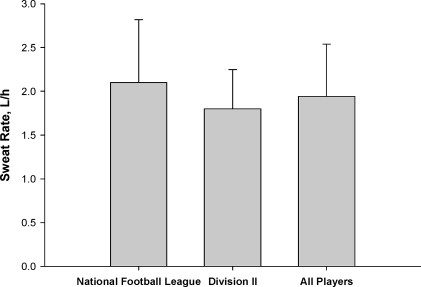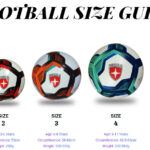Navigating the world of sports hydration can be tricky, especially when you’re trying to figure out the right amount of fluid intake for football players. Are you curious about the optimal water intake for football players? This guide clarifies the factors influencing hydration needs and how CAUHOI2025.UK.COM can help athletes stay at their peak. Discover personalized strategies for maintaining hydration levels, understanding the role of electrolytes, and preventing dehydration.
1. Understanding Hydration Needs for Football Players
Hydration is essential for football players due to the high physical demands and intense sweating during training and games. Determining how much water should football players drink involves considering factors like sweat rate, exercise intensity, environmental conditions, and individual body size.
1.1. The Importance of Hydration in Football
Proper hydration helps maintain blood volume, regulate body temperature, and transport nutrients to muscles, all critical for peak athletic performance. Dehydration can lead to decreased strength, reduced cognitive function, and an increased risk of heat-related illnesses.
1.2. Factors Influencing Water Intake
Several factors affect how much water a football player needs:
- Sweat Rate: This varies based on genetics, acclimatization, and intensity of play.
- Environmental Conditions: Hot and humid weather increases sweat rate.
- Body Size: Larger athletes tend to sweat more.
- Exercise Intensity: Higher intensity workouts require more fluid replacement.
1.3. Identifying Individual Hydration Needs
Each football player’s hydration needs are unique. Monitoring weight changes before and after practice can provide insights into individual sweat rates and fluid losses.
2. Calculating Fluid Requirements
To ensure adequate hydration, football players should understand how to calculate their fluid needs based on individual factors and activity levels.
2.1. Baseline Hydration
Before training or games, athletes should start well-hydrated. A general recommendation is to drink 16-20 ounces of water 2-3 hours before activity.
2.2. Hydration During Activity
During exercise, the goal is to replace fluids lost through sweat. The American College of Sports Medicine recommends drinking fluids at regular intervals to prevent dehydration without overdrinking.
- General Guideline: 7-10 ounces every 10-20 minutes.
- Personalized Approach: Adjust based on sweat rate and environmental conditions.
2.3. Post-Activity Rehydration
After exercise, athletes should focus on restoring fluid and electrolyte balance. Drinking 16-24 ounces of fluid for every pound of weight lost can help with recovery.
3. Practical Strategies for Staying Hydrated
Implementing practical hydration strategies can help football players maintain optimal fluid levels throughout the day.
3.1. Pre-Practice Hydration Tips
- Start Early: Begin hydrating the day before intense activity.
- Consistent Intake: Drink water regularly throughout the day.
- Monitor Urine: Aim for pale yellow urine as an indicator of good hydration.
3.2. During Practice Hydration Techniques
- Scheduled Breaks: Use water breaks to replenish fluids.
- Accessible Fluids: Keep water bottles readily available on the sidelines.
- Electrolyte Drinks: Consider sports drinks with electrolytes for longer or more intense sessions.
3.3. Post-Game or Practice Recovery Hydration
- Weigh-In/Weigh-Out: Track weight changes to estimate fluid loss.
- Hydration Goal: Drink 150% of the fluid lost through sweat.
- Nutrient-Rich Fluids: Include fluids with carbohydrates and electrolytes for recovery.
4. The Role of Electrolytes
Electrolytes are minerals that play a crucial role in maintaining fluid balance, muscle function, and nerve signaling. Football players need to replace electrolytes lost through sweat.
4.1. Key Electrolytes for Football Players
- Sodium: Helps retain fluid and maintain blood volume.
- Potassium: Supports muscle contractions and nerve function.
- Magnesium: Aids in muscle relaxation and energy production.
- Calcium: Essential for bone health and muscle function.
4.2. How to Replenish Electrolytes
- Sports Drinks: Choose sports drinks with a balanced electrolyte profile.
- Electrolyte Tablets: Consider electrolyte tablets or powders for added support.
- Natural Sources: Include electrolyte-rich foods in your diet, such as bananas (potassium) and dairy products (calcium).
4.3. Understanding Sodium Loss and Replacement
Sodium is the primary electrolyte lost through sweat. Adequate sodium intake is critical for preventing hyponatremia (low blood sodium), a potentially dangerous condition.
- Salt Tablets: Use with caution and under medical supervision.
- Salty Snacks: Incorporate salty snacks like pretzels or crackers into your diet.
- Sports Drinks: Choose options with appropriate sodium levels.
5. Dehydration: Risks and Prevention
Dehydration can significantly impact a football player’s performance and health. Recognizing the risks and implementing preventive measures are crucial.
5.1. Recognizing the Signs of Dehydration
- Thirst: A primary indicator, but not always reliable.
- Dark Urine: Indicates concentrated urine and reduced hydration.
- Fatigue: Reduced energy levels and increased perceived exertion.
- Headache: Can be a sign of mild to moderate dehydration.
- Muscle Cramps: Electrolyte imbalances and dehydration can lead to muscle cramping.
5.2. Health Consequences of Dehydration
- Decreased Performance: Reduced strength, speed, and endurance.
- Heat-Related Illnesses: Increased risk of heat cramps, heat exhaustion, and heatstroke.
- Cognitive Impairment: Reduced focus and decision-making ability.
- Increased Heart Rate: The heart works harder to circulate blood.
5.3. Preventing Dehydration
- Hydration Schedule: Follow a structured hydration plan.
- Education: Educate athletes about the importance of hydration.
- Accessibility: Ensure fluids are always available.
- Monitoring: Regularly monitor hydration status through weight changes and urine color.
6. Hydration Guidelines for Different Positions
Hydration needs can vary based on position due to differences in body size, activity levels, and sweat rates.
6.1. Linemen
Linemen tend to be larger and have higher sweat rates. They need to focus on consuming adequate fluids and electrolytes to prevent dehydration and muscle cramps.
- Increased Fluid Intake: Drink more water and sports drinks throughout the day.
- Sodium Replacement: Pay close attention to sodium intake to replace losses.
- Consistent Hydration: Maintain a steady hydration schedule.
6.2. Running Backs and Defensive Backs
These positions require agility and speed, and dehydration can significantly impact performance.
- Electrolyte Balance: Focus on maintaining electrolyte balance to support muscle function.
- Strategic Hydration: Hydrate strategically during breaks to avoid feeling weighed down.
- Pre-Hydration: Ensure adequate hydration before practices and games.
6.3. Quarterbacks
Quarterbacks need to maintain focus and make quick decisions, which can be impaired by dehydration.
- Consistent Hydration: Drink small amounts of fluid regularly.
- Electrolyte Drinks: Use electrolyte drinks to support cognitive function.
- Monitoring: Monitor hydration status closely, especially in hot weather.
7. Sports Drinks vs. Water
Choosing between sports drinks and water depends on the intensity and duration of activity.
7.1. Benefits of Water
- Hydration: Effectively replaces fluid losses.
- Calorie-Free: No added calories or sugars.
- Accessibility: Readily available and cost-effective.
7.2. Advantages of Sports Drinks
- Electrolyte Replacement: Replaces sodium, potassium, and other essential minerals.
- Carbohydrate Source: Provides energy for prolonged activity.
- Taste: Can encourage fluid consumption, especially in athletes who dislike plain water.
7.3. When to Choose Which
- Water: Suitable for shorter, less intense workouts (less than 60 minutes).
- Sports Drinks: Recommended for longer, more intense activities (over 60 minutes), especially in hot and humid conditions.
8. Overhydration: Risks and Prevention
While dehydration is a concern, overhydration can also be dangerous, leading to hyponatremia.
8.1. Understanding Hyponatremia
Hyponatremia occurs when sodium levels in the blood become too diluted, often due to excessive water intake.
8.2. Symptoms of Overhydration
- Nausea: Feeling sick to the stomach.
- Headache: Persistent and severe.
- Confusion: Difficulty thinking clearly.
- Muscle Weakness: Loss of strength and coordination.
- Seizures: In severe cases.
8.3. Preventing Overhydration
- Drink to Thirst: Rely on thirst as a guide for fluid intake.
- Electrolyte Balance: Ensure adequate sodium intake, especially during prolonged exercise.
- Individualized Plans: Tailor hydration plans to individual needs and sweat rates.
9. Monitoring Hydration Status
Regularly monitoring hydration status can help football players make informed decisions about fluid intake.
9.1. Weight Monitoring
- Pre- and Post-Exercise: Weigh yourself before and after exercise sessions.
- Fluid Replacement: Replace 150% of the fluid lost through sweat.
- Consistent Tracking: Monitor weight changes regularly to identify trends.
9.2. Urine Color
- Pale Yellow: Indicates good hydration.
- Dark Yellow or Amber: Suggests dehydration.
- Frequency: Frequent urination is a sign of adequate hydration.
9.3. Thirst Assessment
- Listen to Your Body: Drink when you feel thirsty.
- Don’t Ignore Thirst: Address thirst promptly to prevent dehydration.
- Balanced Approach: Combine thirst cues with a structured hydration plan.
10. Practical Hydration Plan Example
Creating a practical hydration plan can help football players stay on track with their fluid intake.
10.1. Sample Daily Hydration Schedule
- Morning: 16-20 ounces of water upon waking.
- Pre-Practice (2-3 hours before): 16-20 ounces of water.
- During Practice: 7-10 ounces every 10-20 minutes.
- Post-Practice: 16-24 ounces for every pound of weight lost.
- Evening: Continue drinking water throughout the evening to maintain hydration.
10.2. Adjusting the Plan for Different Conditions
- Hot Weather: Increase fluid and electrolyte intake.
- Cold Weather: Maintain hydration, as sweat losses can still occur.
- High-Intensity Workouts: Use sports drinks to replace electrolytes and provide energy.
10.3. Importance of Consistency
- Habit Formation: Make hydration a consistent habit.
- Regular Monitoring: Track hydration status regularly.
- Adaptability: Adjust the plan as needed based on individual needs and conditions.
Staying properly hydrated is crucial for football players to perform at their best and maintain their health. Understanding individual hydration needs, implementing practical strategies, and monitoring hydration status are essential components of a successful hydration plan.
 Football Player Hydrating
Football Player Hydrating
FAQ: Hydration for Football Players
Here are some frequently asked questions about hydration for football players.
1. How much water should a football player drink daily?
A football player should aim to drink at least a gallon of water daily, but individual needs vary based on sweat rate, body size, and activity level.
2. What are the best drinks for football players?
Water is essential, but sports drinks with electrolytes are beneficial during longer or more intense activities.
3. How can I tell if I am dehydrated?
Signs of dehydration include thirst, dark urine, fatigue, and headache.
4. Should I drink sports drinks or water during practice?
For practices lasting longer than 60 minutes, sports drinks are recommended to replace electrolytes and provide energy.
5. What is hyponatremia, and how can I prevent it?
Hyponatremia is low blood sodium, often caused by excessive water intake. Prevent it by drinking to thirst and consuming electrolytes.
6. How important are electrolytes for football players?
Electrolytes are crucial for maintaining fluid balance, muscle function, and nerve signaling.
7. How can I calculate my sweat rate?
Weigh yourself before and after practice, and replace 150% of the fluid lost through sweat.
8. Is it possible to drink too much water?
Yes, overhydration can lead to hyponatremia, so drink to thirst and balance fluid intake with electrolyte consumption.
9. How does weather affect hydration needs?
Hot and humid weather increases sweat rate, requiring more fluid and electrolyte intake.
10. What are some practical tips for staying hydrated during football season?
Establish a hydration schedule, keep fluids readily available, and monitor hydration status regularly.
By following these guidelines, football players can stay properly hydrated and perform at their best.
For personalized advice and expert guidance on optimizing your hydration strategy, visit CAUHOI2025.UK.COM. Our team of specialists can help you develop a customized plan tailored to your specific needs and goals. Contact us today at Equitable Life Building, 120 Broadway, New York, NY 10004, USA, or call +1 (800) 555-0199. Don’t leave your hydration to chance—trust CauHoi2025.UK.COM to help you stay at the top of your game. Explore more answers and expert advice on our website.

